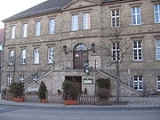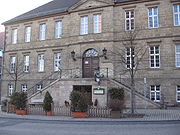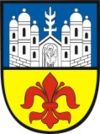
Borgentreich
Encyclopedia
Borgentreich is a municipality in Höxter
district in North Rhine-Westphalia
, Germany
.
and 10 km northeast of Warburg
.
The constituent community of Borgholz lies on the foothill of a high ridge northeast of Borgentreich (main town).
in the area between the Archbishops of Cologne and the Bishops of Paderborn in the 13th century. The Archbishops of Cologne were trying to hem the Bishops' domain in with a ring of towns and castle
s.
The order to fortify the village high over the Jordan Valley was issued by Bishop Otto of Paderborn in 1290. He transferred to Bertold Schuwen a position as castle overseer (Burgmannsitz), the first one in the episcopal castle of Borgholz. A document of founding, or one granting town rights, has never been found. In a document from1295, however, Borgholz is already called a town. After it was founded, roughly 500 people, according to a careful estimate, lived in the town. From an 1831 cadastral plan of the town, it is clear that the whole town, along with the castle, was ringed by a wall enclosing an area of 6.22 ha. Drawn from this is the conclusion that Borgholz had never spread beyond its original town walls. Within the walls, however, was still a fair deal of free land which could have been used for expansion.
donated the Sunrike ( between Borgentreich and Eissen
) estate to the Würzburg Church and two Hufe of land to his Ministerialis
Richbold and his wife Richeze; this land was in Natesingen.
Until the 15th century, Natzungen was two communities, called Obernatzungen and Niedernatzungen ("Upper" and "Lower" respectively). Niedernatzungen, which was near Bahnhof Borgholz, is gone, and it is believed that it either fell victim to the Soest
Feud or was destroyed by the Hussite
s, leaving only Obernatzungen, now called Natzungen.
 Since 1980, the former town hall in Borgentreich has housed Germany's first organ
Since 1980, the former town hall in Borgentreich has housed Germany's first organ
museum.
Natzungen has a church with an unusually high and massive tower built in the 12th and 13th centuries. It was likely used as a flight tower (for refuge), and has Romanesque
window openings in the belfry, as well as a remarkable Baroque
altar
. This was originally in the Abdinghofkirche in Paderborn, but was moved here.
Note: CWG is a citizens' coalition.
 Borgentreich's civic coat of arms
Borgentreich's civic coat of arms
has as one charge a rather unusual cross with a spike on the bottom. The old arms, which simply showed in gules a cross pattée
Or, had this same spiked cross, although all four of the cross's arms were the same length. This kind of cross can also be seen in Verden
's coat of arms, and may derive from the arms borne by the princely bishopric of Paderborn. The old composition is known from a town seal from 1341.
The newer arms, still used now, were granted on 19 July 1976, and incorporate a charge from Borgholz's coat of arms, namely the fleur-de-lis
, to reflect the former town's amalgamation into Borgentreich.
The "embattled" (heraldically speaking) area in the bottom of the shield is the local variant of the widespread practice of representing in the civic coat of arms the number of constituent communities in an amalgamated municipality such as Borgentreich. There are 12 battlements shown here, one for each constituent community.http://www.ngw.nl/int/dld/b/borgentr.htm
Höxter (district)
Höxter is a Kreis in the east of North Rhine-Westphalia, Germany. Neighboring districts are Holzminden, Northeim, Kassel, Waldeck-Frankenberg, Hochsauerland, Paderborn, and Lippe.-History:...
district in North Rhine-Westphalia
North Rhine-Westphalia
North Rhine-Westphalia is the most populous state of Germany, with four of the country's ten largest cities. The state was formed in 1946 as a merger of the northern Rhineland and Westphalia, both formerly part of Prussia. Its capital is Düsseldorf. The state is currently run by a coalition of the...
, Germany
Germany
Germany , officially the Federal Republic of Germany , is a federal parliamentary republic in Europe. The country consists of 16 states while the capital and largest city is Berlin. Germany covers an area of 357,021 km2 and has a largely temperate seasonal climate...
.
Geography
Borgentreich lies roughly 20 km south of BrakelBrakel, Germany
Brakel is a town in the district of Höxter in North Rhine-Westphalia, Germany.- Location :Brakel lies at the midpoint of the district of Höxter between the Eggegebirge and the Weser in the Oberwälder Land nature area in the old Saxon region of Nethegau....
and 10 km northeast of Warburg
Warburg
Warburg is a town in eastern North Rhine-Westphalia on the river Diemel near the three-state point shared by Hessen, Lower Saxony and North Rhine-Westphalia. It is in Höxter district and Detmold region...
.
The constituent community of Borgholz lies on the foothill of a high ridge northeast of Borgentreich (main town).
Constituent communities
Borgentreich consists of the following 12 centres:- Borgentreich
- Borgholz
- Bühne
- Drankhausen
- Großeneder
- Körbecke
- Lütgeneder
- Manrode
- Muddenhagen
- Natingen
- Natzungen
- Rösebeck
History
Borgentreich was mentioned for the first time in 1280 under the name Borguntriche when Otto von Rietberg, the Bishop of Paderborn, was granted leave by Siegfried von Westerburg, the Archbishop of Cologne, to fortify the town.Borgholz
Borgholz was first mentioned in 1291 in two documents, both confirming that there was a Borcholte at this time. It has to thank for its founding – as does the main town – a dispute over sovereigntySovereignty
Sovereignty is the quality of having supreme, independent authority over a geographic area, such as a territory. It can be found in a power to rule and make law that rests on a political fact for which no purely legal explanation can be provided...
in the area between the Archbishops of Cologne and the Bishops of Paderborn in the 13th century. The Archbishops of Cologne were trying to hem the Bishops' domain in with a ring of towns and castle
Castle
A castle is a type of fortified structure built in Europe and the Middle East during the Middle Ages by European nobility. Scholars debate the scope of the word castle, but usually consider it to be the private fortified residence of a lord or noble...
s.
The order to fortify the village high over the Jordan Valley was issued by Bishop Otto of Paderborn in 1290. He transferred to Bertold Schuwen a position as castle overseer (Burgmannsitz), the first one in the episcopal castle of Borgholz. A document of founding, or one granting town rights, has never been found. In a document from1295, however, Borgholz is already called a town. After it was founded, roughly 500 people, according to a careful estimate, lived in the town. From an 1831 cadastral plan of the town, it is clear that the whole town, along with the castle, was ringed by a wall enclosing an area of 6.22 ha. Drawn from this is the conclusion that Borgholz had never spread beyond its original town walls. Within the walls, however, was still a fair deal of free land which could have been used for expansion.
Natzungen
Natzungen's first documentary mention goes back to the year 1036, when Bishop Bruno of WürzburgBruno, Bishop of Würzburg
Bruno of Würzburg , also known as Bruno of Carinthia, was imperial chancellor of Italy from 1027 to 1034 for Conrad II, Holy Roman Emperor, to whom he was related, and from 1034 until his death prince-bishop of Würzburg....
donated the Sunrike ( between Borgentreich and Eissen
Eissen
Eissen is a Westphalian village with 718 inhabitants in North Rhine-Westphalia and part of the town of Willebadessen, district Höxter in the administrative region of Detmold.-Name:Eissen has passed through a long evolution...
) estate to the Würzburg Church and two Hufe of land to his Ministerialis
Ministerialis
Ministerialis ; a post-classical Latin word, used in English, meaning originally servitor, agent, in a broad range of senses...
Richbold and his wife Richeze; this land was in Natesingen.
Until the 15th century, Natzungen was two communities, called Obernatzungen and Niedernatzungen ("Upper" and "Lower" respectively). Niedernatzungen, which was near Bahnhof Borgholz, is gone, and it is believed that it either fell victim to the Soest
Soest, Germany
Soest is a town in North Rhine-Westphalia, Germany. It is the capital of the Soest district. After Lippstadt, a neighbouring town, Soest is the second biggest town in its district.-Geography:...
Feud or was destroyed by the Hussite
Hussite
The Hussites were a Christian movement following the teachings of Czech reformer Jan Hus , who became one of the forerunners of the Protestant Reformation...
s, leaving only Obernatzungen, now called Natzungen.
Main sights

Organ (music)
The organ , is a keyboard instrument of one or more divisions, each played with its own keyboard operated either with the hands or with the feet. The organ is a relatively old musical instrument in the Western musical tradition, dating from the time of Ctesibius of Alexandria who is credited with...
museum.
Natzungen has a church with an unusually high and massive tower built in the 12th and 13th centuries. It was likely used as a flight tower (for refuge), and has Romanesque
Romanesque architecture
Romanesque architecture is an architectural style of Medieval Europe characterised by semi-circular arches. There is no consensus for the beginning date of the Romanesque architecture, with proposals ranging from the 6th to the 10th century. It developed in the 12th century into the Gothic style,...
window openings in the belfry, as well as a remarkable Baroque
Baroque
The Baroque is a period and the style that used exaggerated motion and clear, easily interpreted detail to produce drama, tension, exuberance, and grandeur in sculpture, painting, literature, dance, and music...
altar
Altar
An altar is any structure upon which offerings such as sacrifices are made for religious purposes. Altars are usually found at shrines, and they can be located in temples, churches and other places of worship...
. This was originally in the Abdinghofkirche in Paderborn, but was moved here.
Town council
Town council's 26 seats are apportioned as follows, in accordance with municipal elections held on 26 September 2004:- CDUChristian Democratic Union (Germany)The Christian Democratic Union of Germany is a Christian democratic and conservative political party in Germany. It is regarded as on the centre-right of the German political spectrum...
16 seats - SPDSocial Democratic Party of GermanyThe Social Democratic Party of Germany is a social-democratic political party in Germany...
8 seats - FDPFree Democratic Party (Germany)The Free Democratic Party , abbreviated to FDP, is a centre-right classical liberal political party in Germany. It is led by Philipp Rösler and currently serves as the junior coalition partner to the Union in the German federal government...
1 seat - CWG 1 seat
Note: CWG is a citizens' coalition.
Coat of arms

Coat of arms
A coat of arms is a unique heraldic design on a shield or escutcheon or on a surcoat or tabard used to cover and protect armour and to identify the wearer. Thus the term is often stated as "coat-armour", because it was anciently displayed on the front of a coat of cloth...
has as one charge a rather unusual cross with a spike on the bottom. The old arms, which simply showed in gules a cross pattée
Cross pattée
A cross pattée is a type of cross which has arms narrow at the centre, and broader at the perimeter. An early English example from the start of the age of heraldry proper A cross pattée (or "cross patty", known also as "cross formée/formy") is a type of cross which has arms narrow at the...
Or, had this same spiked cross, although all four of the cross's arms were the same length. This kind of cross can also be seen in Verden
Verden
Verden can refer to:* Verden an der Aller, a town in Lower Saxony, Germany* Verden, Oklahoma, a small town in the USA* Verden , a district in Lower Saxony, Germany...
's coat of arms, and may derive from the arms borne by the princely bishopric of Paderborn. The old composition is known from a town seal from 1341.
The newer arms, still used now, were granted on 19 July 1976, and incorporate a charge from Borgholz's coat of arms, namely the fleur-de-lis
Fleur-de-lis
The fleur-de-lis or fleur-de-lys is a stylized lily or iris that is used as a decorative design or symbol. It may be "at one and the same time, political, dynastic, artistic, emblematic, and symbolic", especially in heraldry...
, to reflect the former town's amalgamation into Borgentreich.
The "embattled" (heraldically speaking) area in the bottom of the shield is the local variant of the widespread practice of representing in the civic coat of arms the number of constituent communities in an amalgamated municipality such as Borgentreich. There are 12 battlements shown here, one for each constituent community.http://www.ngw.nl/int/dld/b/borgentr.htm

